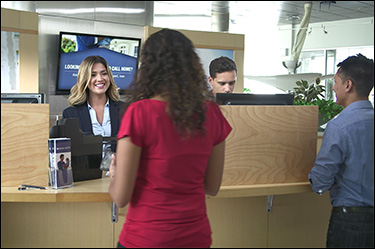Bank tellers have a challenging job in many respects. They are often the face of the bank to its customers and sometimes the
 only human face the customer will experience at the bank. Doing a teller’s job with skill, precision, speed and a friendly smile is crucial to improved customer experience and loyalty. Tellers are also responsible for seeking cross-sell opportunities, navigating through the bank’s teller software application, balancing transactions, and balancing their cash drawer at the end of each day. On top of all of these responsibilities, banks are now adding the responsibility of scanning check deposits into the system.
only human face the customer will experience at the bank. Doing a teller’s job with skill, precision, speed and a friendly smile is crucial to improved customer experience and loyalty. Tellers are also responsible for seeking cross-sell opportunities, navigating through the bank’s teller software application, balancing transactions, and balancing their cash drawer at the end of each day. On top of all of these responsibilities, banks are now adding the responsibility of scanning check deposits into the system.
Where Do We Start?
The introduction of teller check capture is met with a variety of responses from tellers. Some are excited to streamline their jobs and processes, while others may see it as more work in an already busy job. Training can be a critical feature to improve employee morale and acceptance of teller scanning, as well as making the whole experience positive for the tellers.
Each scanner operates slightly different from the others, so it is important, especially when moving from one scanner brand to the other to make sure the training is specific to the brand of scanner and model your bank will be using. Whether it is proper feeding techniques, the need for proper jogging, proper scanner cleaning techniques and frequencies, properly removing items caught in the scanner track, and how to read and properly understand error messages from the device or the software, training and retraining will make the whole experience more positive and the process more efficient.
Sticky Training
As would be expected, tellers are always trained on the scanners prior to the branch rollout of teller capture; however, it is often not considered to conduct post-rollout training to ensure that best practices are being reinforced. Conducting training two to four weeks after the scanners have been rolled out to the branches and put into operation is a great way to reinforce proper operation, maintenance, and trouble-shooting practices for teller image capture. This training is often more effective than the initial training as the tellers have had time to become familiar with the scanners and will have run into different scenarios while operating them that they can bring into the classroom to work through. The bottom line is that training always “sticks” better when a teller has already had experience using the scanner.
We’re Here to Help!
Digital Check is willing to work with your organization to develop and participate in best-practices reinforcement training. For more information about Digital Check scanners and the training we offer, please contact us at 847-446-2285 or fill out our web contact form.





